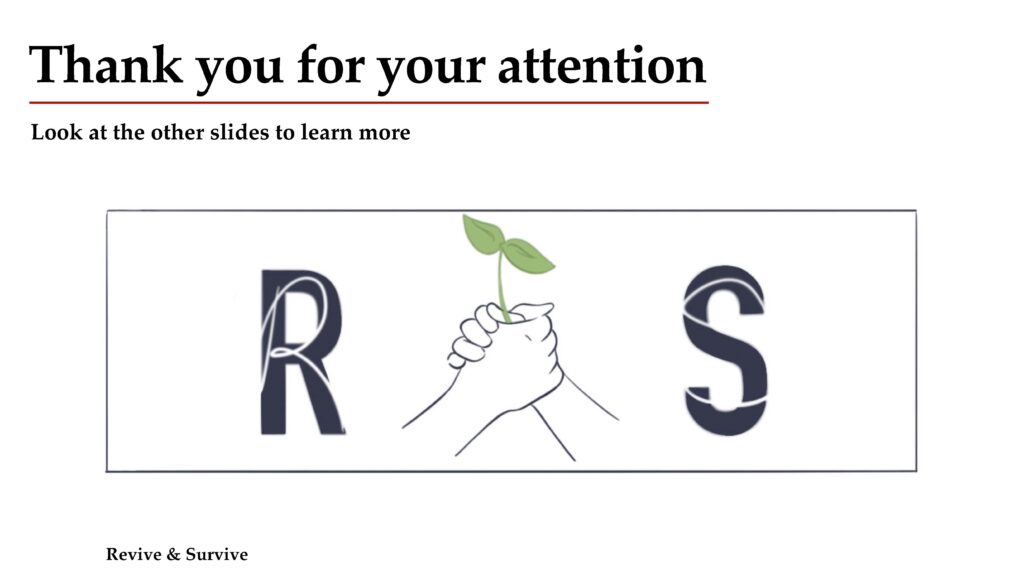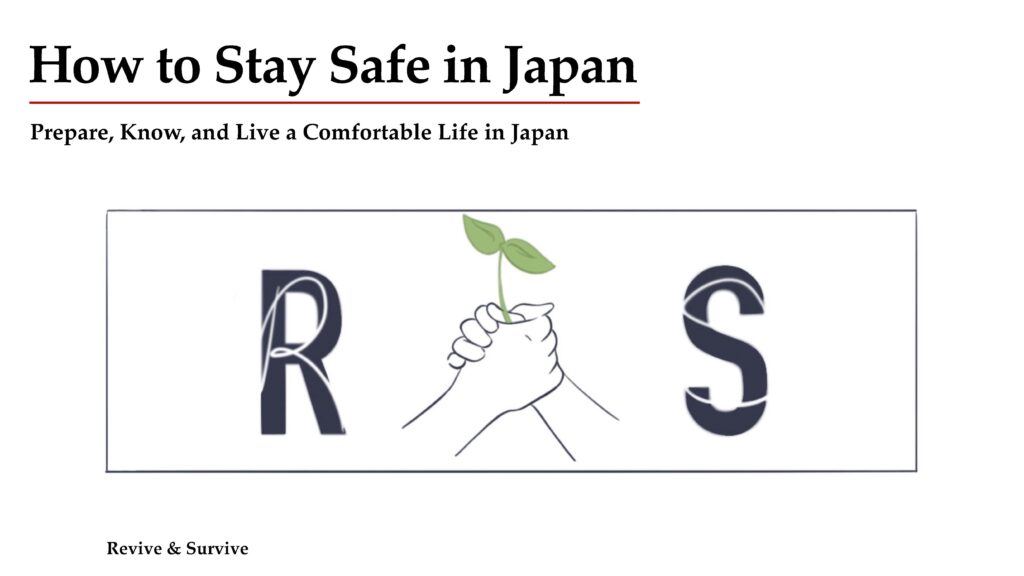
What is this website about?
Imagine the ground beneath you suddenly shaking, your surroundings rattling, and being consumed by the waves of uncertainty that follow. Earthquakes can strike without warning, but with the right preparation, we can significantly reduce their impact on our lives. Today, we’re going to explore essential strategies and practical tips that will prepare you to stay safe, protect your loved ones, and navigate the aftermath of an earthquake with confidence.
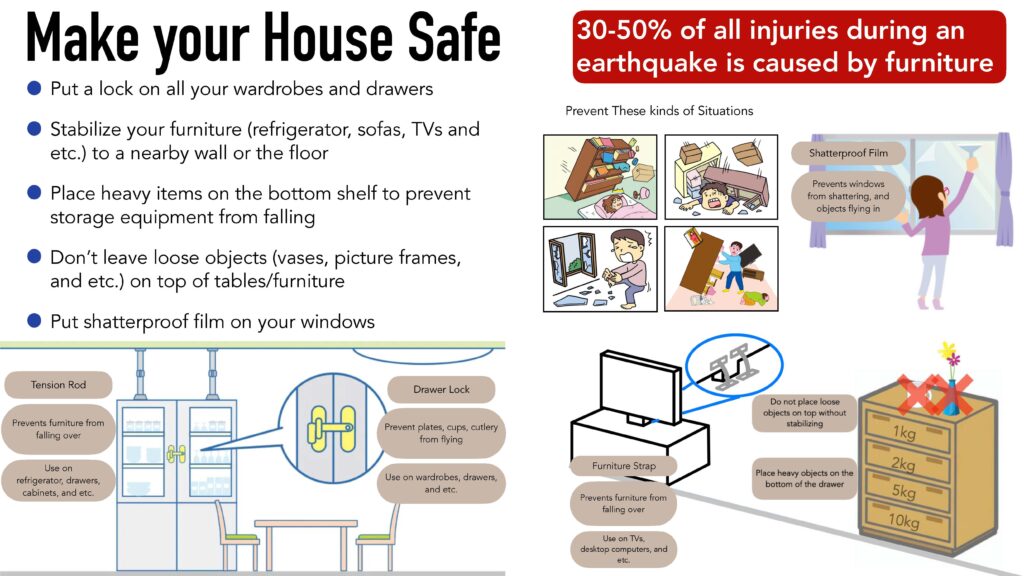
Why is it important to do preparation inside your home?
Ensuring the safety of your home for an earthquake is crucial for several reasons. As aforementioned, earthquakes can strike without warning, sometimes even while you’re asleep, leaving little time to react. With 30-50% of injuries during an earthquake being caused by furniture, taking the correct precautions at home can be the key difference for you and your family to stay safe and evacuate.
During the heavy shaking of an earthquake, the contents of your wardrobes, drawers, and cabinets, such as sharp cutlery, and heavier objects such as pots can quickly go from harmless everyday objects to potential dangers, capable of inflicting serious harm. The same can be said for loose objects that have been placed on top of tables and/or furniture as well as the furniture itself, which can fall over with crushing force. During the 2011 Tohoku earthquake in Miyagi Prefecture, the violent tremors launched a piano into the air, slamming it into the wall and ripping a horrifying hole through it. Other loose objects also pose other risks such as fire hazards, and the blockage of potential evacuation routes.
Now, what measures can you take to ensure safetiness inside your home?
Fortunately, there are preventative measures you can take to keep such scenarios from occuring in the event of an severe earthquake. First is to put a lock on all wardrobes, drawers, and cabinets to keep their contents inside. Regarding the contents in drawers, heavier objects should be placed on the bottom shelves to prevent them from falling, and any loose, unsecured objects should be put away, or stabilized in place. Furniture should be secured against the ceiling, wall, or floor with equipment like tension rods, furniture straps, and specialized metal fittings. Finally, to prevent windows from shattering during the tremors as well as to prevent objects that come falling from both outside and inside, a shatterproof film should be applied.
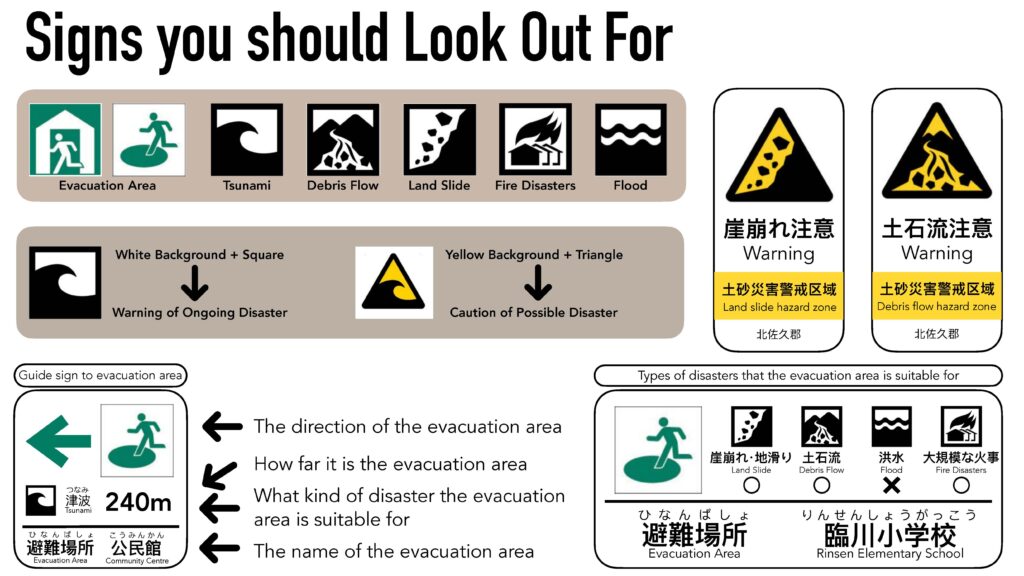
Why is it important to learn these signs?
Remembering the meanings of signs is crucial for quick and effective action during an earthquake. Understanding these signs can significantly enhance safety for individuals and communities.
Public places and buildings in Japan are equipped with signs indicating safe zones, evacuation routes, and emergency exits. Familiarity with these signs will allow you to navigate quickly and efficiently during a disaster, reducing panic and confusion.
Additionally, understanding warning signs related to various natural disasters is essential for being aware of potential dangers in the immediate area. Different key features on the signs hold their respective meanings, which when understood, can provide invaluable information prior to, or during a disaster.
Moreover, community preparedness often relies on shared knowledge of emergency protocols. When everyone understands the meanings of specific signs, it creates a more cohesive response during a disaster. This collective awareness can lead to better coordination in evacuations and rescue efforts, ultimately saving lives.
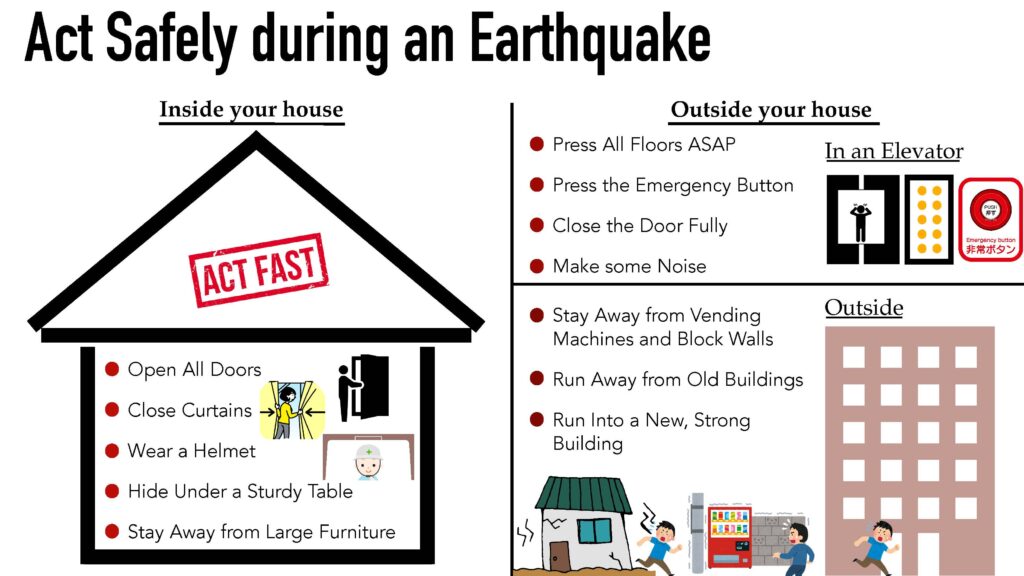
How should you act when you are inside your house, and it starts shaking?
While indoors during an earthquake, it’s important to stay away from windows, mirrors, and anything that could shatter or fall. Wear a helmet and take cover under a sturdy piece of furniture, such as a table or desk. If none is available, protect your head and neck with your arms. It’s crucial to hold on to your shelter (or your position if you’re not under anything) until the shaking subsides to ensure you remain safe from falling debris. Stay indoors until the shaking stops and you’re certain it’s safe to exit, as many injuries occur when people rush outside during tremors. If it is safe to do so, turning off gas and electricity can help prevent fires. Furthermore, to enhance safety, consider opening all doors to allow for easy exit once the shaking stops, as doors may jam due to structural shifts. Closing curtains can also protect against shattered glass and debris.
How should you act when you are inside an elevator, and it starts shaking?
If you find yourself in an elevator during an earthquake, stay inside and do not attempt to exit until the shaking has stopped. Press all floor buttons to stop the elevator at the nearest floor, and also press the emergency button to alert building personnel. Make sure the elevator doors are completely closed, as sometimes they may simply be stuck. In many instances, fully closing the doors can trigger the mechanism to reopen them. When trapped, make noise by shouting or using a whistle to signal for help. Staying inside the elevator during shaking is safer than attempting to exit, as elevators can get stuck between floors, posing a risk of falling through the gap.
How should you act when you are outside, and it starts shaking?
If you find yourself outside during an earthquake, quickly move to an open area away from old buildings, trees, streetlights, and utility wires that could fall. Once in a clear space, drop to the ground to avoid being knocked over by the shaking. Stay alert for potential hazards, such as falling debris, vending machines and block walls, as these can topple or collapse. If possible, find and run into a newer, strong tall building capable of withstanding the aftershocks or tsunamis that may follow.

Why is it important to make evacuation routes?
When an earthquake strikes, clear communication with family in advance can help coordinate evacuation efforts, provide reassurance, and facilitate quick decision-making. By discussing evacuation plans in advance, family members can clearly understand where to go and feel reassured that they’ll reunite at a predetermined location. Reuniting with loved ones is essential as it provides emotional support, alleviating fear and anxiety in the aftermath of such a traumatic event.
What do you need to be careful about to ensure a safe evacuation route?
Plan at least two evacuation routes from different locations, such as home, workplace, and school, that lead to an evacuation center. Both routes should avoid hazards like cliffs, mountains, and rivers, which can pose additional risks during an earthquake. It’s also important that the streets are wide enough to accommodate emergency vehicles and allow for easy movement. Similarly, establish these safe paths to allow for detours in case of obstacles like collapsed buildings or fires. Ensure that the routes are well-lit because evacuation could occurs at night. Adequate lighting at night time can help prevent accidents and guide individuals safely to their destinations. If your evacuation routes cross any bridges, verify that they are earthquake-proof. Familiarize yourself and your family with areas prone to landslides, flooding, or building collapses. Knowing these zones can enhance your preparedness and response during an emergency, allowing you to make informed decisions about evacuation routes and safety measures.
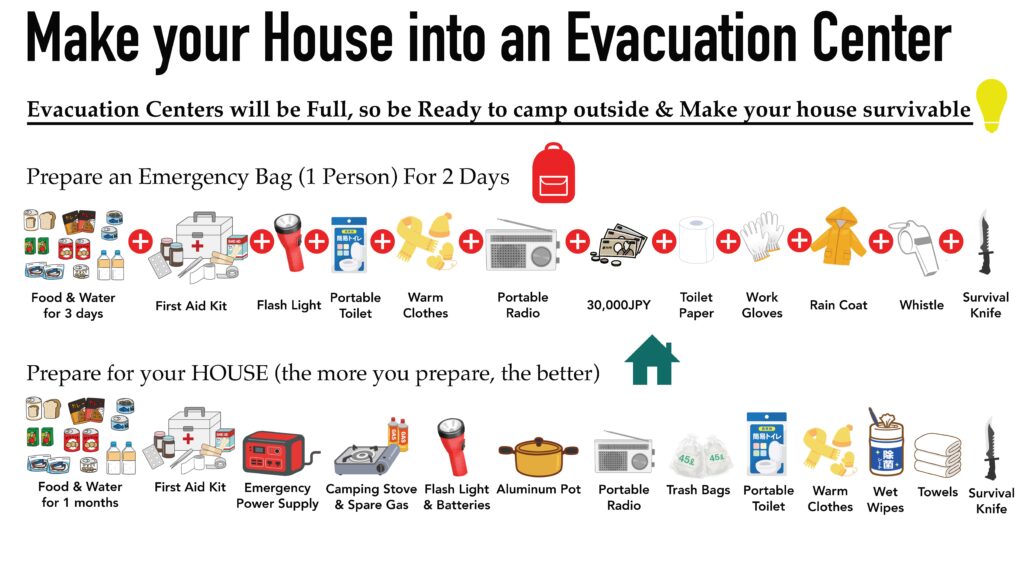
What do you need to stock up on?
Preparing an emergency bag for an earthquake is essential for ensuring safety and comfort in the aftermath of such a disaster. An emergency bag should be easily accessible and contain supplies to sustain you and your family for at least 48 hours, although it’s wise to consider longer-term needs, especially in cases of severe disruptions. This preparation can make a significant difference in how well you cope during the initial aftermath of an earthquake.
What items should you pack in an emergency bag?
One of the most critical items to include in your emergency bag is water. It’s recommended to store at least 3 liters of water per person per day. Along with water, you should also pack non-perishable food items. For a family of four, you should plan for at least 2,000 calories per person per day.
What items should you stock up on for your personal home?
One of the most critical items to include in your emergency bag is water. It’s recommended to store at least 3 liters of water per person per day. It is important to prepare at least 340 litres of water for one month in your home, ensuring you have enough for drinking, cooking, and hygiene needs. Store water in sealed containers and replace it every six months to maintain its freshness. Along with water, you should also pack non-perishable food items. Aim for a variety of foods that require little or no preparation, such as canned goods, dried fruits, nuts, and energy bars. For a family of four, you should plan for at least 2,000 calories per person per day, totaling about 240,000 calories for one month. Focus on foods with a long shelf life and regularly check expiration dates to ensure they remain safe to consume. It’s also crucial to consider your power needs during an emergency. Preparing an emergency power supply, such as a portable generator, can provide essential electricity for lights, refrigeration, and medical devices. Ensure you have enough fuel for your generator, and follow safety guidelines to avoid carbon monoxide poisoning. Furthermore, having camping stoves and spare gas can be invaluable for cooking when conventional methods are unavailable. These stoves are typically compact and easy to use, allowing you to prepare meals even if the power is out.
What should you stock in both your emergency bag, and home?
In addition to food and water, a comprehensive first aid kit is crucial. This kit should include bandages, antiseptics, pain relievers, and any necessary prescription medications. A reliable flashlight, along with extra batteries, is also essential for navigating in the dark. Consider including a multi-tool or Swiss Army knife, which can be invaluable for various tasks, from opening cans to making repairs. Personal hygiene items, such as portable toilets, soap, hand sanitizer, toothbrushes, toothpaste, feminine hygiene products, and toilet paper, should not be overlooked, as maintaining hygiene is important even in emergencies. Include lightweight emergency blankets, change of clothes, sturdy shoes, and warm layers. It’s also wise to store copies of important documents, such as identification, insurance policies, and medical records, in a waterproof bag, alongside about 30,000 yen of cash, as ATMs and credit card machines may not function during a disaster. Having a portable radio is essential for staying informed about the situation and making well-informed decisions on what to do next. In emergency situations, especially if you’re trapped or lost, a whistle can be used to alert rescuers to your location. The sound of a whistle can travel much farther than a human voice, making it a more effective way to signal for help.
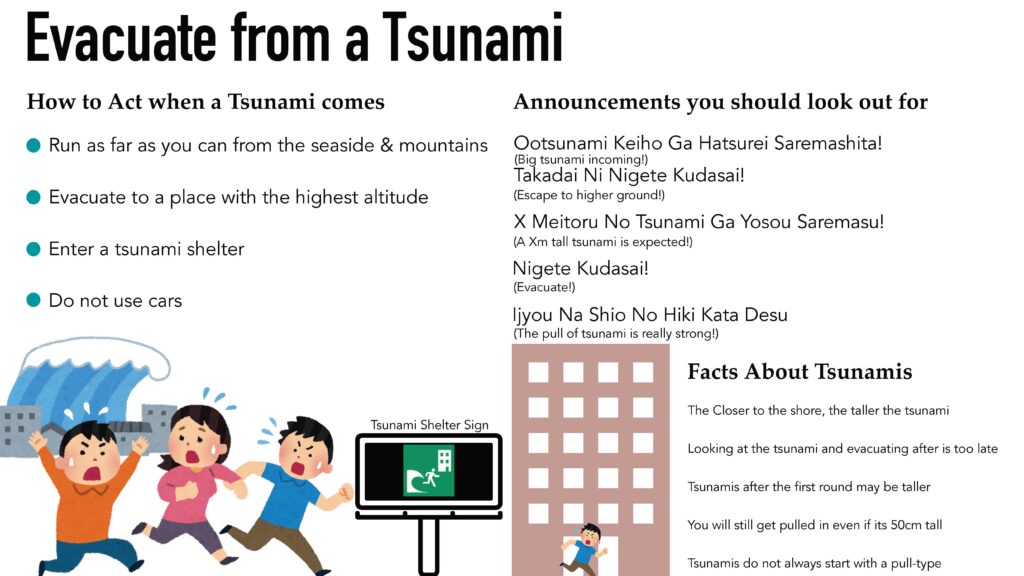
A tsunamis coming! What actions should I take?
If a tsunami warning is issued, evacuate immediately. Run as far as possible from the seaside and avoid mountainous areas, as these can create dangerous conditions. Instead, head toward places with higher altitude, such as hills or designated evacuation sites. It is vital to avoid using cars, as roads may become congested and hinder your escape. Instead, use marked evacuation routes on foot to reach safer locations quickly. If you cannot evacuate in time, find a tall sturdy building, and secure location away from windows and doors to protect yourself from potential harm.
During the tsunami, continue to listen for updates from local radio or TV broadcasts. If you are unable to reach higher ground, it is safest to remain indoors and away from windows until the tsunami has passed. If there are designated tsunami shelters nearby, consider entering them for additional protection. After the tsunami, wait for the announcement that the tsunami has ended before returning to affected areas. Be cautious of potential aftershocks, which can trigger additional tsunami waves. Once it is safe, check on family and neighbors, especially those who may need assistance.
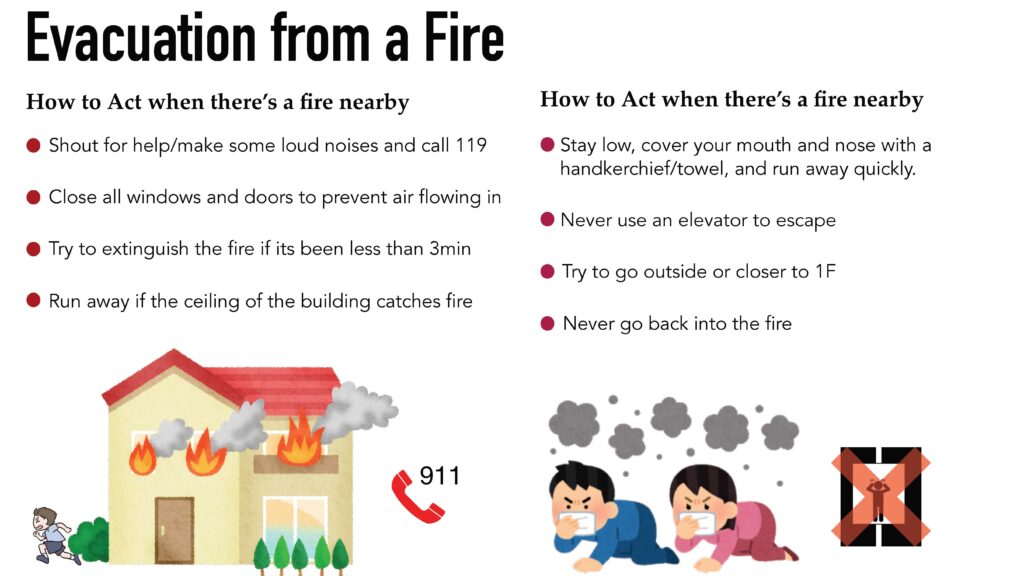
There’s a fire in the house! What should I do?
In the event of a fire nearby, it is essential to act quickly and calmly to ensure your safety and that of those around you. First, stay informed and assess the situation. If you notice smoke or flames, or if you hear alarms, look for signs of evacuation or listen for announcements from authorities. If you are trapped, shout for help or make loud noises to alert others to your location.
If you are in a building where a fire is detected, evacuate immediately. Follow the designated evacuation routes and avoid using elevators, as they may become inoperable. Instead, use the stairs to exit the building. If the fire is small and has just started (within the first three minutes), you may attempt to extinguish it using a fire extinguisher, but only if it is safe to do so.
If you encounter smoke, stay low to the ground, as smoke rises. If you find yourself trapped, signal for help from a window and stay low to avoid smoke inhalation. This will help you avoid inhaling toxic fumes, and covering your mouth and nose with a handkerchief or towel can provide additional protection. Move quickly to a safe location, preferably outside or a floor close to the ground floor. While evacuating, if the fire is still small and it is safe to do so, try to close all windows and doors behind you to help prevent air from fueling the fire.
How should you act when you get out of the fire?
Once you are outside, move to a safe distance from the building, ideally to a designated assembly point. Do not attempt to re-enter the building until emergency services declare it safe. Finally, listen for instructions from emergency responders, as they may provide information on when it is safe to return or offer additional safety guidance. Also get your health checked by an incoming ambulance.
